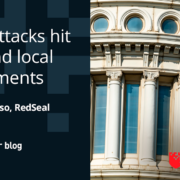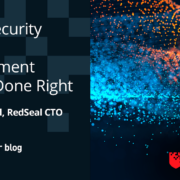Recent pandemic pressures have created the perfect storm for state and local cybersecurity breaches. With some staff still working from home, state and local agencies face the challenge of deploying defense at a distance over networks, connections, and applications that are often insecure, unencrypted, and in many cases unapproved. What’s more, ransomware has surged — a significant problem since less than 40 percent of state and local staff members have received training on how to prevent cyberattacks.
The result is an increasing volume of local and state government cybersecurity threats, which are occurring across the country. For example, GovTech reported that an issue with third-party software exposed more than 38 million health records across states, including Texas, Indiana, Maryland, and New York. Another case reported by Healthcare IT News detailed a smaller-scale breach in California caused by a single employee that occurred over ten months and exposed both patient and employee data.
With hybrid work here to stay and cyberattacks on the rise, government organizations need to improve cybersecurity practices. They must focus on protecting against breaches that can compromise data, impair operations, and cause significant expenses.
Identifying the Biggest Barriers in Effective Defense
Before agencies can deploy better cybersecurity measures, they must identify critical vulnerabilities and threat vectors. And while every state and local government faces unique data handling and security challenges, three barriers to effective defense are common: visibility, accessibility, and resiliency.
Visibility
Traditionally, state and local governments have been behind the curve when it comes to technology adoption. As noted by research firm Deloitte, however, evolving citizen expectations around access and ease of use “will require uprooting outdated systems and practices and replacing them with new models.” As a result, agencies are now looking to expand their agility to streamline service availability and improve collaboration. To meet these goals, many have integrated and deployed cloud-based software, platforms, and infrastructure.
While these solutions offer improved agility and efficiency, they introduce significant new security risks. IT teams can not keep track of every app and service in use, which reduces visibility while simultaneously expanding the total attack surface.
Accessibility
For most state and local governments, the problem here isn’t too little access for employees that require it — it’s too much for those that don’t. One common example of excessive access occurs when staff complete one project and move to another. In many cases, their existing permissions aren’t revoked. Instead, new access is simply layered on top of the old, which creates a security risk. And with insider threats often more challenging to detect than their external counterparts, it’s now critical for agencies to identify, control, and correct for excessive access.
Resiliency
Most state and local governments have familiar security controls such as firewalls and antivirus scanners in place to catch potential threats. However, many lack the tools and tactics required to remediate issues when they occur, mitigate the amount of damage done and get services back up and running.
The result is IT environments that are primed to respond but struggle with resiliency. To effectively manage evolving threat landscapes, state and local governments need security plans and policies covering all aspects of an attack — from initial compromise to identification, isolation, remediation, and restoration.
Exploring the Issue of State and Local Breaches
So what do these breaches look like in practice? Let’s explore the impact of three recent scenarios.
1) New York State, January 2020
In January 2020, New York state officials found themselves up against a massive cyberattack that disabled access to databases used by the state’s civil service, environmental department, and police force. Likely the work of foreign actors, the hack went unreported for months, even as officials looked to restore critical access.
As noted by Security Today, the state received word about a potential flaw — and available patch — for its Citrix-based systems in December 2019. Unfortunately, the state did not install the patch in time to prevent the issue. As a consequence, more than 80,000 state devices were vulnerable to malware compromise. While it appears attackers didn’t access any citizen data, the state had to cover the costs of a three-week forensic investigation of more than 40 servers.
2) Multiple Municipalities, June 2021
Local government cybersecurity teams often look to save time and money by using the same services as other municipalities. It makes sense: They’ve been proven to work with government systems and generally have a track record for reliability.
However, if service providers become compromised, the results can be far-reaching. As reported by ZDNet, that’s what happened across dozens of municipalities in the US when a Massachusetts software provider used misconfigured Amazon S3 buckets. As a result, more than 1,000 gigabytes (GB) of data and 1.6 million files were exposed. Compromised data included email addresses, physical addresses, and driver’s license information, along with deed and tax records.
3) Oldsmar, Florida, February 2021
A cyberattack on Oldsmar, Florida in 2021 didn’t compromise data access or expose files. Instead, it nearly poisoned the town’s 15,000 residents. On February 5th, a plant operator at the local water treatment facility received an alert that someone had gained remote system access. The attacker opened multiple applications and services and then increased the concentration of sodium hydroxide — also called lye — to 100 times its normal level. Fortunately, operators were able to retake control and cancel the change quickly and prevent disastrous consequences.
Grant Funding for State and Local Governments
The good news is some new help is on the horizon for local and state government cybersecurity, thanks to the $1.2 trillion infrastructure package. The plan includes $1 billion in cybersecurity grants to help local and state governments boost their defense. If approved, the new program would offer $200 million worth of grants in 2022, $400 million in 2023, $300 million in 2024, and $100 million in 2025. In addition, the plan funds creation of a response and recovery fund at the Cyber and Infrastructure Security Agency (CISA), which would give an additional boost to cybersecurity efforts.
Mitigating the Impact of Cybersecurity Threats
Mitigating the impact of local and state cybersecurity threats depends on a strategy of defense in depth. In practice, this requires a three-step approach: Identification, evaluation, and implementation.
Identification focuses on finding potential threats in current cyber defenses — such as those tied to open source software, authorized apps, excessive access, and unintended exposure to the Internet. Evaluation includes internal and external assessment of existing security policies to see what’s working, what isn’t, and what vulnerabilities state and local governments need to prioritize. Finally, implementation looks to deploy security solutions that directly address key concerns, such as comprehensive cloud security services that provide visibility into public, private, and hybrid stacks simultaneously to empower threat detection and response.
Battening Down the Hatches
State and local governments now face a trifecta of security challenges: remote work, ransomware, and worker education. The combination creates ideal circumstances for malicious actors. By taking advantage of ideal compromise conditions, attackers can breach government networks, access critical services, and exfiltrate citizens’ data.
The result is a growing need to batten down the digital hatches by creating and implementing an in-depth strategy to help build robust, reliable, and resilient security infrastructure. To prevent risks and a host of unwanted outcomes, state and local governments need to prioritize cybersecurity.
Ready to boost cyber resiliency and better weather the storm? Click here to see a demo of RedSeal’s cloud security solution in action.
Join us!
Hear from Shannon Lawson, CISO, City of Phoenix, how the state and local agency leaned toward hardening their environment from attacks, recognized exposures, secured infrastructures, mitigated risks, and stayed compliant. The live webinar is January 18, 2022. Register now and don’t miss out!


